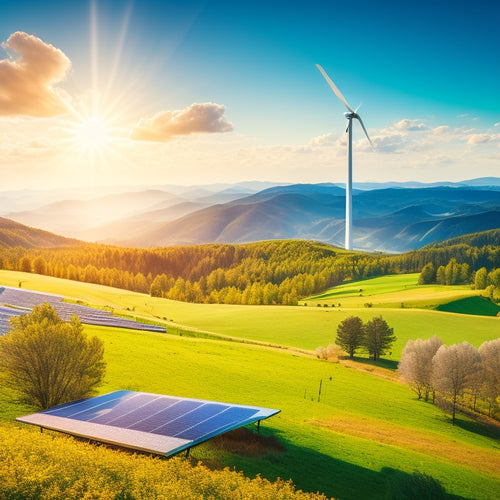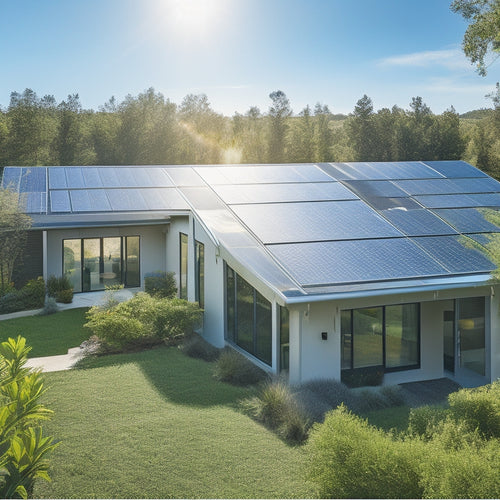
Best Outdoor Energy Storage Solutions
Share
When you're looking for the best outdoor energy storage solutions, consider solar battery systems and lithium-ion batteries. These options provide high energy density and longevity, helping you make the most of renewable energy effectively. Assess your space requirements to guarantee proper installation, and focus on systems with a high energy efficiency rating for peak performance. Additionally, investigate portable power stations for versatility during outdoor excursions. Investing in quality solutions not only enhances energy independence but also reduces long-term costs. To make the best choice for your specific needs, there's more to examine regarding technologies and specifications.
At a Glance
- Solar battery systems provide eco-friendly energy storage, allowing users to harness renewable energy and store it for later use.
- Portable power stations offer mobility and versatility, making them ideal for outdoor activities and emergency backup power.
- Lithium-ion batteries are preferred for their high energy density and long lifespan, enhancing sustainability and energy independence.
- Understanding battery specifications, such as energy density and discharge rate, is crucial for selecting the best energy storage solution.
- Investing in energy storage systems can lead to long-term savings and reduced reliance on fossil fuels, enhancing overall energy management.
Eco-Friendly Energy Storage Option
When considering eco-friendly energy storage options, solar battery systems and portable power stations stand out as effective solutions.
These technologies not only utilize renewable energy but also enhance your outdoor activities by providing reliable power.
Lithium-ion battery systems, in particular, offer high energy density and long lifespan, making them an ideal choice for sustainable energy storage in outdoor settings.
By integrating these systems, you can greatly reduce your carbon footprint while enjoying the convenience of stored energy.
high energy density allows for efficient energy storage that supports a variety of devices during your excursions.
Solar Battery Systems
As the demand for sustainable energy solutions grows, solar battery systems have emerged as a significant eco-friendly option for energy storage. These systems allow you to utilize solar energy efficiently, storing excess power generated during the day for use at night or during outages.
When selecting a solar battery, it's crucial to evaluate solar panel compatibility, ensuring your battery system integrates seamlessly with your existing solar setup. You should assess the energy needs of your household and determine the appropriate battery capacity to meet those demands.
In addition, conducting a battery lifespan evaluation is important; different battery technologies, such as lithium-ion or lead-acid, offer varying lifespans and performance characteristics. Investing in high-quality solar batteries not only maximizes your energy independence but also reduces reliance on fossil fuels, contributing to a cleaner environment.
Furthermore, these systems can be scaled to fit your needs, allowing for flexibility in your energy management strategy. By understanding the technical specifications and compatibility of solar battery systems, you can make informed decisions, ensuring that you achieve the freedom and sustainability you desire.
Portable Power Stations
Solar battery systems provide a strong solution for home energy needs, but portable power stations offer unique advantages for those seeking mobility and versatility in eco-friendly energy storage.
These compact units allow you to utilize power on the go, making them ideal for camping, road trips, or emergency backup.
When considering portable power stations, you'll find various battery types, including lithium-ion and lead-acid.
Lithium-ion batteries are favored for their lightweight design and efficiency, while lead-acid options may provide a lower upfront cost.
Understanding these differences will help you select a station that meets your energy demands.
Charging methods also play a vital role in portability.
Most power stations can be charged via standard wall outlets, car chargers, or solar panels, giving you flexibility in how you recharge your device.
This adaptability guarantees you have access to energy in diverse environments, enhancing your outdoor experience.
Cost-Effective Long-Term Investment
When considering outdoor energy storage solutions, you'll find that initial installation costs can be significant.
However, understanding critical optimization factors like energy storage capacity and power output can lead to a more informed purchasing decision.
Analyzing the long-term savings potential reveals a persuasive return on investment that often outweighs these upfront expenses.
Initial Installation Costs
While initial installation costs for outdoor energy storage solutions might seem high, they can be viewed as a cost-effective long-term investment. When you conduct an initial investment analysis, you'll recognize that these systems offer notable advantages beyond the upfront price tag. By integrating energy storage into your setup, you enhance your energy independence, giving you control over your power usage and costs.
Effective budget planning strategies are essential in this scenario. You should consider financing options or incentives that can ease the burden of these initial expenses. Many manufacturers provide rebates or tax credits that can markedly offset your costs.
Additionally, investing in quality systems can yield lower maintenance and operational costs over time, making it easier to achieve a favorable return on investment.
When evaluating your options, think about the potential added value of energy storage, not just regarding savings but also in enhancing your energy resilience. As you weigh your choices, remember that the upfront costs are only one piece of the puzzle; focusing on the long-term benefits will enable you to make an informed decision that aligns with your desire for freedom and sustainability.
Long-Term Savings Potential
Understanding the long-term savings potential of outdoor energy storage solutions can greatly influence your investment decision. By integrating these systems into your energy strategy, you're not just enhancing your energy independence; you're also positioning yourself for significant energy savings over time.
When you store energy generated during peak production hours, you minimize reliance on grid power, especially during high-demand periods when rates spike. This proactive approach to energy management aligns with effective financial planning, allowing you to budget more accurately and forecast savings.
Moreover, many jurisdictions offer incentives or rebates for adopting renewable energy technologies, further multiplying your potential savings. As you consider installation costs, remember that these upfront investments typically pay for themselves within a few years through reduced utility bills and incentives.
Additionally, outdoor energy storage solutions often require minimal maintenance, which translates to low ongoing expenses. In the long run, you'll find that the initial costs become a fraction of the cumulative savings achieved through efficient energy use and management.
Embracing this technology isn't just about saving money; it's about gaining the freedom to control your energy future.
Key Specifications Overview
When evaluating outdoor energy storage solutions, you'll want to focus on key specifications like battery capacity, portability, and durability.
Lithium-ion batteries, for instance, are preferred for their high energy density and long lifespan, making them ideal for outdoor use. Understanding these factors will help you determine which systems can best meet your energy needs while withstanding outdoor conditions.
Additionally, consider systems with high round-trip efficiency, as they minimize energy losses during usage, ensuring high-performance energy storage in real-world applications.
Let's investigate how each specification impacts performance and usability in real-world applications.
Battery Capacity Considerations
Battery capacity evaluations play an important role in selecting the right energy storage solution for outdoor applications. When assessing batteries, you'll want to focus on energy density and discharge rate. Energy density refers to the amount of energy stored per unit of weight or volume, which is vital for optimizing space and portability. Meanwhile, the discharge rate indicates how quickly the battery can release its stored energy, impacting performance during peak demand.
Here's a quick overview of key specifications to contemplate:
| Specification | Description |
|---|---|
| Energy Density | Determines how much energy you can store in a given space. Higher energy density means more energy in less weight. |
| Discharge Rate | The speed at which energy is released. A higher discharge rate provides power for demanding applications. |
| Cycle Life | Refers to how many charge/discharge cycles the battery can undergo before its capacity markedly drops. |
| Depth of Discharge | The percentage of the battery's capacity that can be used without damaging it. A deeper discharge allows for more usable energy. |
Understanding these specifications will help you make informed decisions that enhance your outdoor energy independence.
Portability and Durability
Evaluating battery capacity is just one aspect of choosing the right energy storage solution for outdoor applications; portability and durability are equally important. When you're out in nature, you need a storage system that can withstand the elements and be easy to transport.
Look for solutions that feature a lightweight design, making it simple to carry and set up wherever you are.
Durability is critical in outdoor environments. Opt for units with weather resistance ratings that can handle rain, snow, and extreme temperatures. This guarantees your energy storage solution won't fail when you need it most.
Additionally, consider models made from sturdy materials that can resist impacts and abrasions, enhancing their longevity.
Another factor to assess is the ease of handling. Many modern outdoor energy storage devices come equipped with built-in handles or wheels, further maximizing portability.
By prioritizing these factors, you'll not only enhance your outdoor experience but also guarantee you have reliable energy storage that can keep up with your explorations.
Assess Your Space Requirements
To effectively assess your space requirements for outdoor energy storage, start by measuring the area where you plan to install the system.
Consider the location's accessibility, potential environmental impacts, and any zoning regulations that may apply.
It's also important to evaluate the specific energy needs of your household to determine the appropriate size of the battery bank and solar components needed for your setup, guaranteeing compatibility with essential components.
Accurate measurements and thoughtful location considerations will guarantee the system fits seamlessly into your outdoor setup.
Space Measurement Techniques
When planning for outdoor energy storage solutions, accurately measuring your available space is vital. Start by gathering the right tools to guarantee measurement accuracy. A tape measure or laser distance finder can provide precise dimensions of the area you intend to employ.
It's essential to measure not just the length and width, but also the height, especially if you're considering vertical stacking options.
Next, consider any environmental factors that could impact the installation, such as proximity to trees or other structures. Document these elements, as they can influence your spatial optimization strategies.
Once you've recorded your measurements, create a scaled diagram of the space. This visual representation will help you analyze how different energy storage units could fit within your designated area, allowing you to maximize efficiency.
Lastly, keep in mind any future expansion needs. If you envision increasing your energy storage capacity, factor in additional space during your initial assessments.
Understanding your space requirements through these measurement techniques will enable you to make informed decisions, guaranteeing your outdoor energy storage solution is both functional and optimized for your unique situation.
Location Considerations
Selecting the right location for your outdoor energy storage solution requires careful consideration of various factors that impact both functionality and efficiency.
First, assess your space requirements by evaluating your property's layout and available square footage. You'll want to ascertain there's enough room not just for the storage unit but also for access and maintenance.
Next, consider geographic suitability. Different regions experience varying climate impacts, which can affect the longevity and performance of your energy storage system. For example, areas with extreme temperatures may require additional insulation or protective housing to preserve battery life.
Additionally, think about proximity to your energy generation source, like solar panels. The shorter the distance, the less energy lost during transfer.
You should also evaluate local regulations and zoning laws that may impact your installation. Understanding these legal constraints guarantees you won't face unexpected obstacles down the line.
Higher Energy Efficiency Rating
When considering outdoor energy storage, you'll want to focus on innovative battery technologies that enhance energy efficiency ratings.
These advanced systems optimize energy capture and minimize losses, ensuring you get the most out of your stored energy.
Innovative Battery Technologies
Innovative battery technologies are revolutionizing outdoor energy storage by markedly enhancing energy efficiency ratings. Solid state batteries, for instance, offer significant energy density improvements over traditional lithium-ion systems, enabling you to store more energy in a compact form.
Meanwhile, lithium sulfur advancements are pushing the boundaries of capacity and longevity, making them ideal for extended outdoor use.
Flow battery innovations provide flexible energy management, allowing you to scale storage capacity based on your needs. Coupled with advanced thermal management systems, these technologies guarantee peak performance, even in challenging environments.
The integration of smart battery management systems enhances efficiency by monitoring and optimizing energy use in real-time.
Recycling technologies are also gaining traction, addressing sustainability concerns while minimizing waste. As you consider grid integration solutions, these innovative batteries support seamless connectivity, enabling you to leverage renewable energy sources effectively.
Additionally, wireless charging systems bring convenience to outdoor scenarios, eliminating the hassle of cables. Modular battery designs allow for easy upgrades and expansions, adapting to your changing energy needs.
Together, these advancements equip you to maximize energy efficiency in outdoor storage solutions.
Frequently Asked Questions
What Are the Maintenance Requirements for Outdoor Energy Storage Systems?
When maintaining outdoor energy storage systems, you'll need to guarantee proper solar panel integration and conduct regular battery monitoring. This helps maximize efficiency and lifespan, allowing you to enjoy the freedom of reliable energy storage.
Can Outdoor Energy Storage Systems Withstand Extreme Weather Conditions?
Imagine armor against nature's fury. Outdoor energy storage systems boast temperature resilience and a weatherproof design, ensuring they thrive in extreme conditions. They're built to endure, giving you the freedom to capture energy, rain or shine.
How Long Do Outdoor Energy Storage Solutions Typically Last?
Outdoor energy storage solutions typically last 5 to 15 years. Lifespan factors include usage patterns, environmental conditions, and maintenance. Evaluating performance metrics helps you understand efficiency and durability, ensuring you make informed decisions for your energy needs.
Are There Any Available Warranties for These Energy Storage Solutions?
When investing in energy storage, think of warranties as safety nets. Most solutions offer warranty coverage ranging from 5 to 10 years, ensuring your investment lasts while providing peace of mind throughout the warranty duration.
What Safety Features Should I Look for in Outdoor Energy Storage Systems?
When evaluating outdoor energy storage systems, prioritize fire prevention mechanisms and advanced battery management features. These elements enhance safety, ensuring reliable performance while safeguarding your investment and providing you the freedom to utilize energy efficiently.
Explore More
To sum up, choosing the right outdoor energy storage solution can greatly enhance your energy efficiency and sustainability. By evaluating your space and understanding key specifications, you'll make a cost-effective investment that pays off in the long run. Remember, it's not just about storing energy; it's about utilizing the future of energy like it's 1999. So take the plunge and accept these eco-friendly options to power your outdoor spaces effectively and responsibly.
Related Posts
-

Renewable Energy Solutions to Reduce Your Carbon Footprint
To reduce your carbon footprint, adopting renewable energy solutions is key. Using solar panels or wind turbines can ...
-

Smart Grid Technology Implementation Challenges
You'll encounter several challenges when implementing smart grid technology, particularly in cost management, scalabi...
-

Installing Metal Solar Roofs for Maximum Energy Efficiency
Installing metal solar roofs can drastically enhance your home's energy efficiency and durability. These roofs withst...


